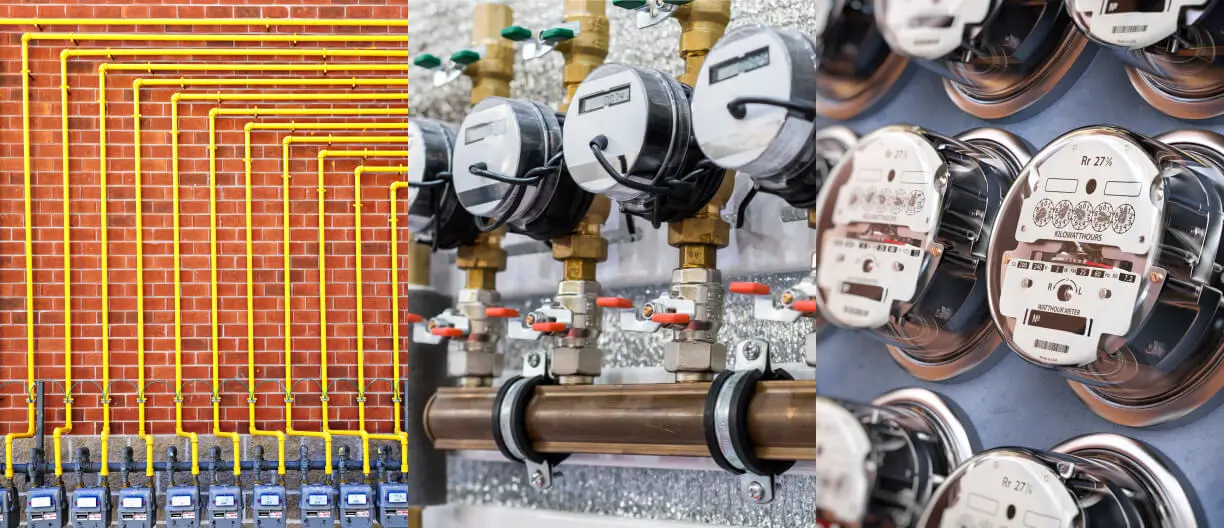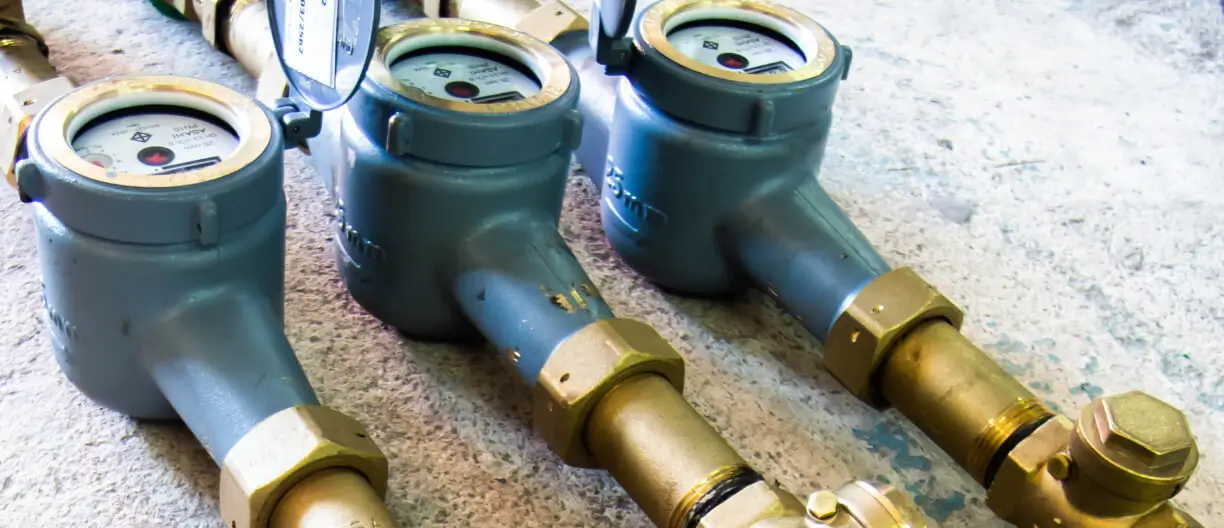Welcome to the Ultimate Guide to Submetering, the comprehensive resource for anyone considering submetering utilities at multi-unit properties. As a property owner or manager, you understand the importance of managing costs, promoting conservation efforts, and maintaining compliance with regulations. Submetering is a powerful tool that can help you achieve these goals and more. In this guide, we will explore the various types of submetering, the advantages of submetering, the installation process, maintenance and monitoring, tenant communication, and real-life case studies. We hope this guide will provide you with the knowledge and confidence you need to make informed decisions about submetering and help you take the necessary steps to implement submetering in your multi-tenant property. If at any moment you’d like to get in contact with us, we’re just a click away. Now, let’s get started!

Submetering Basics and Benefits.
What is submetering?
Submetering involves installing individual meters to measure the consumption of electricity, gas, or water for each tenant in a building or complex. With submetering, each tenant is responsible for their individual usage, and billing is based on actual consumption, promoting fairness and transparency. Additionally, submetering can incentivize tenants to conserve resources and reduce waste, leading to cost savings for both you and your tenants.
The Benefits
Advantages of submetering for small property investors reduces utility costs
Submetering enables property owners to accurately measure and allocate utility costs to individual tenants, which can lead to reduced overall utility expenses.
Increases cash flow: Submetering can help property owners increase their cash flow by recovering utility expenses from tenants.
Improves cap rates and property values: By reducing utility expenses and increasing cash flow, submetering can improve cap rates and increase property values.
Insulates from rising energy prices: Submetering allows property owners to pass on utility expenses to tenants, which can insulate them from rising energy prices.
Encourages tenant energy conservation: Submetering incentivizes tenants to conserve energy by making them directly responsible for their own usage and billing.
Rents more affordable: Submetering can make rents more affordable by reducing overall utility expenses and providing tenants with incentives to conserve energy.
Leak Detection: Submetering can detect leaks or other water usage anomalies, enabling property owners to address them quickly and avoid costly damage.

Selecting the Right Submetering System
How does it work?
Individually meter each unit: Each unit in a multi-tenant property is equipped with an individual meter to measure electricity, gas, or water usage. These meters can be installed during the construction phase of the property or retrofitted later.
Manually or remotely take meter readings: The meter readings are then recorded either manually by a meter reader or remotely through an automated system that sends data to a central server.
Master utility bill costs are divided for each tenant based on their usage: The total cost of the master utility bill for the property is calculated, and each tenant’s portion of the bill is determined based on their individual usage as measured by their submeter.
Tenants receive a bill from the property owner or Submeter Solutions: The property owner or a third-party billing company then sends each tenant a bill for their portion of the utility costs. This billing process promotes transparency and fairness, as each tenant is responsible for their individual usage and only pays for what they consume.Submetering can help property owners accurately allocate utility costs, promote conservation efforts, and increase cash flow. With the individual metering of each unit, tenants have control over their usage and can take steps to reduce their consumption, which can lead to cost savings for both tenants and property owners.
Submetering Applications
Submetering can be categorized into several different applications, including:
Energy management: Installing submeters to monitor energy usage in order to identify areas for conservation and efficiency improvements. This includes monitoring electricity, gas, and water usage to identify areas where usage can be reduced.
Sewer deduct programs: Installing submeters on water lines to accurately measure water usage and avoid paying sewer fees for non-sewage water usage. This includes applications such as irrigation lines, cooling towers, and other non-sewage water usage.
Recovering utility costs from tenants: The primary reason for installing submeters is to allocate utility costs to individual tenants based on their usage. This promotes transparency and fairness, and encourages tenants to conserve resources.Other applications of submetering include:
Renewable energy generation: Installing submeters to track renewable energy generation and accurately allocate credits or charges to individual units or tenants.
Water conservation: Installing submeters to track water usage and identify areas for conservation and efficiency improvements.
Cost savings: Submetering can help reduce utility expenses and increase cash flow for property owners, leading to improved cap rates and property values.
Compliance: Submetering can help property owners maintain compliance with local, state, and federal regulations related to utility usage and allocation.
By understanding these different categories and applications of submetering, property owners can make informed decisions about submetering implementation and ensure that their system meets their unique needs and goals.
Want to learn more? We’ll be happy to assist you.
Choosing the appropriate type of submeters
Choosing the right submeter solution for your property can be a complex process, but there are several key factors to consider to ensure you make the best decision:
Type of submetering: The first step is to determine which type of submetering is appropriate for your property. Do you need to measure electricity, gas, water, or a combination of these utilities?
Accuracy: Look for submeters that are accurate and reliable, ensuring that the readings are as close to the actual usage as possible. This is important for billing accuracy and for encouraging tenants to conserve resources.
Installation process: Consider the ease and convenience of the installation process, as well as the cost and time involved. Look for submeter solutions that can be easily retrofitted into existing buildings or installed during construction.
Compatibility with existing systems: Ensure that the submeter solution is compatible with your existing billing system, property management software, and utility infrastructure.
Maintenance and support: Look for submeter solutions that come with ongoing maintenance and support, including troubleshooting assistance and regular inspections.
Cost: Consider the upfront cost of the submeter solution, as well as ongoing costs such as maintenance and monitoring fees. Look for submeter solutions that provide a good return on investment and can help you reduce overall utility expenses.
Reputation and reviews: Research the submetering provider’s reputation and read reviews from other property owners or managers who have used their services to ensure they have a good track record.
By taking these factors into account and thoroughly researching submetering solutions, you can make an informed decision and choose a solution that meets the unique needs of your property.

Installation and Best Practices
Submeter installation is a critical component of successful submetering implementation. Here are some best practices to consider for submeter installation:
Work with a qualified contractor: Choose a contractor who has experience with submetering installation and can ensure that the job is done correctly and in compliance with local codes and regulations.
Choose the right location: Install submeters in a location that is accessible and allows for easy reading of the meter. Make sure the meter is not obstructed by objects or located in an area that is prone to damage.
Ensure proper wiring: Proper wiring is essential for accurate meter readings. Make sure that the wiring is installed correctly and is in compliance with local codes and regulations.
Test and calibrate the submeters: Before installing submeters, test and calibrate them to ensure accurate readings. This will help prevent issues with billing accuracy and tenant disputes.
Obtain necessary permits and approvals: Obtain all necessary permits and approvals from local authorities before installing submeters. This ensures compliance with local codes and regulations and helps avoid potential legal issues.
Communicate with tenants: Communicate with tenants about the installation process and what to expect. Provide them with clear instructions on how to read the meter and how billing will work.
Perform regular maintenance and inspections: Regular maintenance and inspections of submeters are important to ensure accurate readings and to identify any issues early on. Make sure to schedule regular maintenance and inspections with your contractor.
By following these best practices, you can ensure that your submeter installation is successful and that your submetering system is accurate, reliable, and compliant with regulations.

Billing and Tenant Management
Billing and tenant management are critical components of successful submetering implementation. Here’s an outline of the billing and tenant management process:
Developing a transparent billing process: Develop a clear and transparent billing process for tenants, ensuring that they understand how their utility charges are calculated and what they can do to reduce their usage.Reviewing utility usage online: With submetering, you can review utility usage for each unit online, allowing you to accurately calculate usage and allocate costs to each tenant.
Calculating utility charges for tenants: To calculate utility charges for tenants, you will need to take the rates the city is charging you for the utility (water, sewer, gas) and multiply that by the usage for each unit. This process can be complex, so consider developing a calculator that you can use each month to plug in specific usage for each resident.
Communicating utility usage and charges to tenants: Once you have calculated utility charges for each tenant, you will need to send a bill to each tenant. Make sure to clearly communicate the usage and charges, and provide tenants with a way to contact you with any questions or concerns.
Ensuring accuracy and fairness: It is important to ensure that you do not overcharge tenants for utilities and that you do not make a profit off of utility charges. Keep your charges in line with the actual cost of utilities and be transparent about the billing process to build trust with your tenants.
By following these best practices for billing and tenant management, you can ensure that your submetering implementation is successful and that your tenants are satisfied with the process.
Conclusion
In conclusion, submetering is a powerful tool that can help small property investors manage costs, promote conservation efforts, and maintain compliance with regulations. By installing individual meters to measure the consumption of electricity, gas, or water for each tenant in a building or complex, property owners can accurately allocate utility costs, incentivize tenants to conserve resources, and increase cash flow.
Staying updated on submetering trends is essential to maximizing the benefits of submetering. As technology advances and regulations change, it is important to keep up-to-date with the latest developments in submetering to ensure that your system remains accurate, reliable, and compliant with regulations.
Typical applications of submetering result in an ROI of less than 12 months if all utility costs are recaptured from tenants. This means that submetering can quickly pay for itself and lead to significant cost savings for small property investors.
In summary, submetering is a valuable investment for small property investors that can lead to reduced utility expenses, increased cash flow, improved cap rates, and more sustainable operations.
By staying up-to-date with submetering trends and best practices, small property investors can ensure that their submetering implementation is successful and provides a strong return on investment.
Ready to get started? We’re here to help.
Appendix
Glossary of submetering termsSubmeter: A meter used to measure the consumption of electricity, gas, or water for individual units in a building or complex.
Master Meter: A meter that measures the total consumption of electricity, gas, or water for a building or complex.
Billing: The process of charging tenants for their individual usage of electricity, gas, or water based on submeter readings.
Allocation: The process of allocating utility costs to individual tenants based on their submeter readings.
Consumption: The amount of electricity, gas, or water used by a tenant as measured by their submeter.
Retrofitting: The process of installing submeters in an existing building or complex.
Compliance: Adherence to local, state, and federal laws and regulations related to submetering.
Accuracy: The precision and correctness of submeter readings, measured in terms of the difference between the actual usage and the reading.
Incentive: A reward or motivation to encourage tenants to conserve energy and reduce their consumption.
Monitoring: The ongoing process of tracking submeter readings and utility consumption to identify issues or anomalies and promote conservation.
Maintenance: The regular upkeep of submetering equipment to ensure accuracy and reliability.
Third-party billing: The outsourcing of billing and tenant management to a third-party company to streamline the process and reduce administrative burden.
Data Analytics: The process of analyzing submeter data to identify trends, patterns, and areas for improvement.
Real-time data: Submeter data that is available instantly and continuously, providing real-time insights into energy usage and costs.
Load profiling: The process of analyzing submeter data to identify usage patterns and trends.
Tenant engagement: The process of involving tenants in submetering efforts through communication, education, and incentives.
Utility costs: The costs associated with providing electricity, gas, or water to a building or complex.
Cost recovery: The process of recovering utility costs from tenants through submetering.
Submeter provider: A company that specializes in providing submetering equipment, installation, and maintenance services.
Green building: A building or complex designed to be energy-efficient and environmentally sustainable, often utilizing submetering to promote conservation.
Peak demand: The time period when energy usage is at its highest, often leading to increased energy costs.
Tenant dispute: A disagreement between a tenant and a property owner or manager regarding submetering and utility charges.
Net metering: A system that allows property owners to generate renewable energy and sell excess energy back to the grid, often utilizing submetering to accurately track energy production and usage.
Multi-family housing: Housing that contains multiple units within a single building or complex, often utilizing submetering to allocate utility costs to individual tenants.
Smart grid: A modernized electricity grid that utilizes advanced technology, including submetering, to improve efficiency, reliability, and sustainability.
